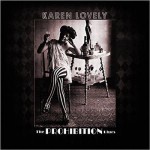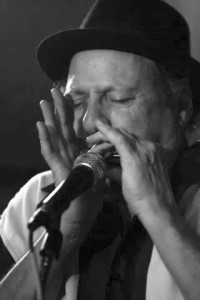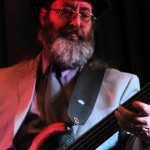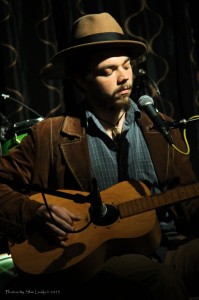![billy2[1]](https://archive.cascadebluesassociation.org/wp-content/uploads/2014/12/billy21.jpg) by John Rumler
by John Rumler
Mine is just another scene
From the world of broken dreams
And the night life, ain’t no good life
But it’s my life
The road for full-time musicians is often rocky and full of hairpin curves and sheer cliffs. For every stretch of straight highway, there’s a dozen potholes.
For every big success, there are hundreds of talented artists toiling in shadowy neighborhood bars, lounges, and biker dives. The blues and rock and roll lifestyle is aptly described by Willie Nelson’s stark and poignant song Night Life—immortalized by BB King, Jimmy Witherspoon, and countless others.
Billy Hagen is an exception. He hit the big time when he was barely out of his teens. His devastating skills as a lead guitarist combined with his uncanny and explosive stage presence propelled him to dizzying heights on a regional level. He did extended stints with the Mel Brown Quartet and Johnny Limbo and the Lugnuts, although poles apart musically, the entities are arguably two of the region’s most durable, popular and respected bands.
A native Oregonian, Hagen grew up in Cedar Hills and Beaverton, where he currently lives. His parents were both stockbrokers.
He played on stage no less than four times with the great Chuck Berry, who himself overcame numerous pitfalls, including three stretches in prison for three different offenses.
One of the more unique personalities in Portland’s pantheon of guitar gods, Hagen is older and wiser these days and perhaps a step slower. The endless parties, countless gigs, and hard living—and the years too–have taken a toll. But, with a guitar in his hands, a stage, and an audience, Hagen can still give chills, still make the hairs on the back of your neck stand at attention. The sudden transformation he undergoes when he steps up on the dais and begins performing is astonishing to those who don’t know him.
The reaction is often quizzical looks, shaking heads, smiles of disbelief, and questions like, “Good Lord, who is that guy?”
Like many kids growing up in the 1960s and 70s, Hagen’s initial introduction to the Blues came through bands such as the Rolling Stones and the Allman Brothers who turned him on to Muddy Waters, T Bone Walker, Jimmy Reed and other blues greats.
“I listened to my big brother Ed’s records, when I was 12, I got my first $15 no-name guitar and a little Fender amplifier. Ed’s friend Casey Thomas showed me my first chords.”
Hagen didn’t dabble. He became nearly obsessed, listening intently to the early Stones covers such as Little Red Rooster and trying to replicate the sound, note for note. After graduating Beaverton High School in 1977, he studied piano and guitar at Mt. Hood Community College and “wood-shedded” constantly and began a lifelong passion for jazz and classical guitar.
He also played in the bands such as Killing Floor, named after the Howlin’ Wolf song. Killing Floor attained a degree of popularity playing blues and an assortment of Allman Brothers, Grateful Dead, and rock and roll tunes. The band featured two lead guitars, a rhythm guitarist and a drummer and played a variety of high school dances, keg parties, and backyard bashes.
Hagen later gained additional seasoning playing guitar and handling the vocals in Freeborn, and Pulse, short-lived but raunchy, high-energy blues-based bands that rocked Portland’s music scene.
He considers Wes Montgomery his strongest musical influence and has played with a host of jazz artists including Mel Brown, Bud Shank, Dave Fleschner and his Jazz Trio and played bass several times, as previously mentioned with Chuck Berry, because there’s only one lead guitarist when Berry is onstage.
A few of his other musical influences include Joe Pass, Keith Richards, Howard Roberts, and Mick Taylor. “My forte would be that I play any and all styles of rock, blues, jazz, pop and classical,” he says.
In 1982, Mike Mason first saw Hagen performing with Johnny Limbo and the Lugnuts at the Silver Moon Tavern—now the Blue Moon– on Northwest 21st Avenue. Mason, who is a bass guitarist and a graphic designer, became close friends with Hagen over the years and was his best man at his wedding. Besides sharing a deep love of music, the two were (and still are) avid Green Bay Packer fans and once took a trip together to see a professional football game at storied Lambeau Field in Green Bay, Wisconsin.
Mason credits Hagen with helping him get started in music, encouraging and coaching him musically and getting him gigs. He played in The Billy Hagen Trip from 1994-96, a raucous, high energy Blues and Rock and Roll Band that played original compositions as well as early Stones, and Santana and Hendrix covers. “Billy’s my hero. He gave me a chance when nobody else did. He believed in me when I didn’t even believe in myself,” he says.
But it wasn’t always happy, carefree, good times, Mason admits. “It was at times a troubled and difficult road. We all have our demons and Billy had his share. Sometimes they got the better of him, but he still is and will always be my best friend.”
Another local musician Dave Gill, has also performed with Hagen on and off over the past quarter of a century and the two are still the best of friends. “Billy’s hard to describe, he defies categorization,” Gill says. “His creative spark is more like a raging inferno.”
While Gill says that Hagen’s musical mastery and level of knowledge is “off the charts,” he also points out that his friend isn’t just a musician, he’s also a natural entertainer. “Before he had a hip replacement a few years ago, Billy could do these acrobatic somersaults and a Mick Jagger routine that his fans adored. He had a long cord on his guitar and he’d walk around playing behind his back and over his head like Guitar Slim, T Bone Walker, and even Jimi Hendrix.”
Over the years, Gill has recorded dozens of Hagen’s live performances and he is a just now transferring them to a digital format. “Billy’s comprehension of music and his range is astonishing,” he says.
Gill points out that for all Hagen’s creative talents and skills and high-octane stage performances, he is amazingly humble when he is out of the spot light. “There can be a bit of snobbery with highly accomplished musicians, especially in jazz, but Billy’s the opposite. He’ll always bend over backwards to help another musician, especially one who was starting out.”
The rock and roll roller coaster is a wild joy ride and is frequently accompanied by drugs, sex and hell-bent-for-leather partying. The frantic energy and hard driving, late night lifestyle eventually took a toll, Gill says. “Sometimes we can all be our own worst enemies.”
Few regional bands, if any, could rival the longevity and popularity of Johnny Limbo and the Lugnuts. Formed in 1978 as a lark, the band has opened for Chuck Berry, Johnny Rivers, Jan & Dean, Chubby Checker, and many other national acts and has toured Japan, Korea, and The Philippines. Although they don’t perform as often as in years past, their popularity is undiminished: Last year, during their summer concerts in the parks, they set new records for attendance.
Jerry Hofman, aka, Johnny Limbo, is the front man and founding member of the band that played well over 100 shows a year during their heyday. He recalls the very first time he saw Hagen performing. “We were looking for a guitarist and Billy was playing at a Rose Garden summer concert in 1979 or 1980. He was a lot younger than any of us, kind of wild and crazy, but WOW, was he impressive.”
The Lugnut band members all had white collar jobs, one was an attorney. They had short 1950s-style haircuts and wore costumes as a part of their “schtick.” They also had a highly disciplined and professional approach to performing and practicing. It was quite an adjustment for Hagen, who had shoulder-length hair and was practically in his teens, but he stayed with the Lugnuts for upwards of 10 years during the band’s peak.
“Billy was an amazing and dynamic performer. He could do a somersault even with his guitar,” Hofman recalls. “He just grabbed a hold of audiences and he did the most dead-on impersonation of Mick Jagger you could imagine. He even looked like him.”
Hofman was the business manager, and bandleader for the Lugnuts and sang and also played several instruments. He said that Hagen is the most talented musician he’s ever known. He tells how once Hagen was lobbying for a second saxophone player in the band. Hofman nixed the idea saying the cost would be prohibitive, so within about a month’s time, Hagen was blowing a mean sax. “While it is a God-given gift, Billy also developed it and he had an encyclopedic knowledge of music, even older music. He also plays piano as well as the guitar, yet he has this other showmanship side of him that is wildly entertaining.”
Young, bursting with energy and eager to please his audiences and band mates, Hagen played with a fanatical intensity somewhere practically every night and he’d often play twice in the same night.
It was non-stop life in the fast lane and Hagen couldn’t get enough. The Lugnuts were a huge draw. There were plenty of gigs at swanky corporate parties, a Far East tour, a splashy show for Nike at the 1984 Summer Olympics in Los Angeles and that’s just for starters. Hagen was burning the candle at both ends, but since he was having the time of his life, he just kept partying.
After 10 years, the young, brilliant and hard-charging lead guitarist began having greater and greater difficulty making the band’s practice sessions. “In 1989 they sort of gave me a choice: Shape up or ship out,” Hagen ruefully recalls. “I chose the latter.”
Today Hagen looks back on his days with the Lugnuts with a different perspective. “Jerry and all those guys, they were all smart, shrewd businessmen. They loved their music and had a great time, but they also knew how to brand and market themselves. They had their act together.”
“I lived the Rock and Roll lifestyle: lots of drugs, lots of girls, lots of parties. I went overboard,” Hagen explains.
The two men have remained close over the years and still talk on the phone at least once a month. “We all truly hated to see Billy go, but it was his own decision,” Hofman says.
After leaving the Lugnuts, Hagen joined one of the region’s most respected and influential bands: the Mel Brown Quartet. He’d been performing with them off and on for months, now he simply became a fixture. It wasn’t exactly a regular gig, because Brown was touring with Diana Ross at the time and had plenty of his own irons in the fire. Brown recalls being surprised at how quickly Hagen adapted to his new environs. “Billy’s extremely gifted musically and he could play similar to Wes Montgomery. Lots of guys can play rock and roll, but very few can play jazz like he did.”
Brown was often gone on nationwide tours for months at a time and as a result, Hagen gradually moved on. “I haven’t seen him in years. It’d be great to play with him again and to see what else he’s learned over the years,” Brown said. “Billy caught on quickly, he could adapt to almost anything.”
During this time in the mid-1980s, the quartet played at the Hobbit in Southeast Portland, the Old Jazz Quarry on Southwest Jefferson in downtown and at the Dublin Pub which was then located on Southeast Belmont Street. Hagen played with Brown for 4 to 5 years. “Since I love playing jazz, it was a great experience for me. I learned a ton of stuff from Mel about music, a lot of it very subtle things. I especially learned to play easier and to mellow out.”
Besides Hagen on lead guitar and Brown on drums, jazz maestros George Mitchell played the Hammond B3, and Brad Harris played bass. “I’d love to see Mel again. It’s been way too long. I’m going to get down to Jimmy Mak’s soon,” Hagen says.
From then on, Hagen formed the Nerve Agents which lasted a few years and he also played off and on with the Dave Fleschner Trio with Ken Ollis on drums. “We did some excellent recordings. That was another bright spot for me,” Hagen says.
Lately Hagen has spent more time focusing on private recordings and giving music lessons. Six months ago, one of his grateful students repaid him with a 1991 Cadillac Sedan de Ville. Perfect timing, because Hagen recently got his driver’s license back. That comes in particularly handy when he is booked for private parties he hires his own musicians that he’s known for decades.
In recent years Hagen has slowed down on the partying and has been “dry” for one year. He’s enjoying his life fully and looking at new musical frontiers. He is often booked for private parties, and when he is, he prefers to hire his own musicians, many of them are former bandmates that he’s known for decades.
While Hagen’s left his mark on the local scene, Hofner said his friend of nearly 35 years could have gone much farther, that he had the stuff to make it nationally. “There’s absolutely nothing Billy can’t play, even beautiful classical guitar. He really should have hit the big time, instead of just sort of hanging around Portland. But Billy’s got a heart of gold and he makes friends wherever he goes. The guy doesn’t have an enemy in the word.”
As the year 2014 winds down, Hagen is now busy working with Mason and Rod Sharer, a vocalist from Oregon City, on a new recording project with Steve Solomon on keyboards. The musicians met while jamming together at a Portland Marathon gig.
“We’re all super-excited about this. It’s a bit of a departure from anything any of us have done in our past,” Mason says.
“We’ve taken our share of lumps in the music business, but things are looking up. Billy’s even got himself another big Caddy like he had back in the old days and we’re really having fun.”
 floor, but are having so much fun they won’t stop until they drop. Now you’ve just envisioned the dance floor at the end of the night after the dancers have danced to Bottleneck Blues Band.
floor, but are having so much fun they won’t stop until they drop. Now you’ve just envisioned the dance floor at the end of the night after the dancers have danced to Bottleneck Blues Band.
![billy2[1]](https://archive.cascadebluesassociation.org/wp-content/uploads/2014/12/billy21.jpg)
 By Laurie Morrisey
By Laurie Morrisey



